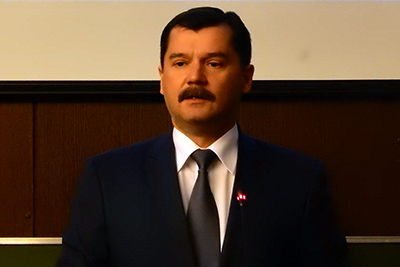
For the sake of historical justice, it must be said that the first commercial flights were opened by the British jet plane Comet (de Havilland Comet) on May 2, 1952. In 1954, the operation of Comet aircraft was been stopped because of the high accident rate associated with insufficient structural strength. 12 aircrafts were lost. Deeply modernised Comet 4 aircraft flew only April 27, 1958. 100 Comet units were built.
Our Tu-104 after the first regular passenger flight was used without interruption for 23 years (until 1979). 201 aircrafts of different modifications were made. It carried more than 100 million passengers, spent in the air 2 million hours, executed 600 thousands flights.
2 years later in 1958 the first US passenger jet Boeing 707 was put into the operation. There were constructed about 1000 aircrafts, such aircrafts are used even now for certain types of work (the army). 194 aircrafts are lost, which is 19% of constructed.
In 1959, the French plane Caravel (Sud Aviation Caravelle) was put into operation. A total number of 280 aircrafts were produced. The plane was used until 2005. Of course, when building aircrafts such as Comet-4, Boeing-707, Caravel the experience gained on the Comet, the available experience gained on the Tu-104 was taken into account.
Very interesting, specific and instructive is the history of creation and operation of Tu-104.
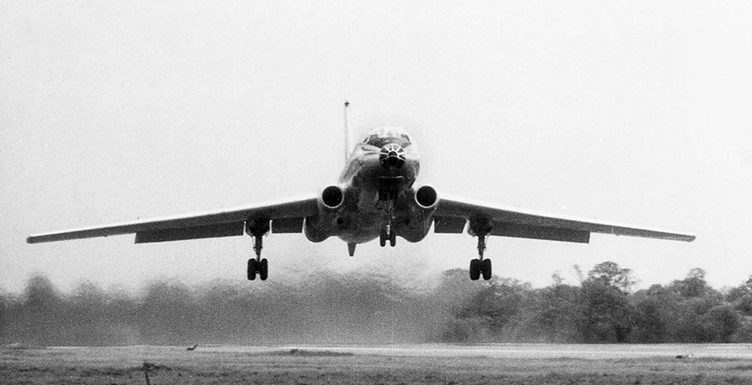
Technical characteristics of the aircraft Tu-104
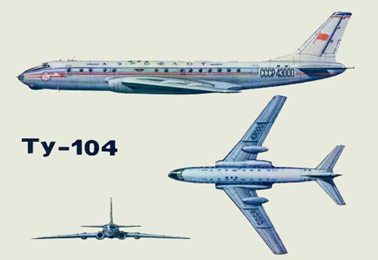
| Basic data of serial Tu-104B with the the turbojet engine RD-3M-500 with a maximum take-off thrust of 9500 kgs | |
|
Aircraft length
|
40,06 m;
|
|
Wingspan
|
34,54 m;
|
|
Aircraft height
|
11,9 m;
|
|
Area of the wing
|
183,5 sq.m;
|
|
Take-off weight
|
78100 kg;
|
|
Commercial load capacity
|
12000 kg;
|
|
Cruising speed
|
750-800 km/h;
|
|
Altitude
|
10000 - 12000 m;
|
|
Range with paid load 12,000 kg
|
2120 km;
|
|
Flight range at full supply of fuel and toll load 8150 kg
|
2750 km;
|
|
Passengers amount
|
100 people
|
|
The crew
|
4-5 people
|
It has only been a decade as our country came out of a difficult war, which had caused great damage to the industry, agriculture, the state's economy as a whole. And as soon as the country fell into the atmosphere of the "cold war" with its threats and the "Iron Curtain." Naturally, in these conditions, priority was given to strengthening of the defence capability. However, the leadership of the state devoted much attention to the development of the air transport communications, to learning and integrating the world trends in this area. Therefore the breakthrough with Tu-104 on the timing, level and mass operation was not casual. It leaned on the social and economic needs, intellectual baggage and industrial might of the Soviet Union. Not one country in the world could create in 2 years a completely new and unique features for passenger jet and organize its mass uninterrupted operation on domestic and international routes in such a short time.
It was a labor victory of millions of people, experience and lessons which have yet to be fully comprehend. Reasonable use of the experience and lessons give a positive result in our time.
The creation of the aircraft is better told by the veteran of the domestic and international aircraft building, the chief designer of OKB A.N. Tupolev Alexander Shengardt. Let me just highlight some points.
State plan for the development of civil aviation in the years 1956-1960 was to increase passenger traffic by 3.8 times, cargo turnover in 2 times, to introduce in operation on main air lines high-speed multi-seat aircraft, to reconstruct the country's main airports. Previously created a wonderful airplane Il-14, couldn’t satisfy these requirements no longer. The transition to a productive civilian airplanes - jets was needed. In addition, there had appeared the first specimen in the world of aviation - the British Comet.
Leaders of Civil Aviation, Ministry of Aviation Industry leading design bureau and industrial research institutes were looking for ways to solve this complex problem. The necessary components for its solution were clearly defined. Such as:
- Modern aircraft and land vehicles;
- Qualified personnel;
- Infrastructure;
- Organization.
At the end of 1953, Design Bureau headed by its general director, Andrei Nikolayevich Tupolev came with a proposal to the country's leadership and Aeroflot to create on the basis of long-range bomber Tu-16 passenger jet aircraft with two the Alexander Mikulin`s (AM-3) turbojet engines. By this time, Tupolev Design Bureau on its own initiative has led the elaboration of the project.
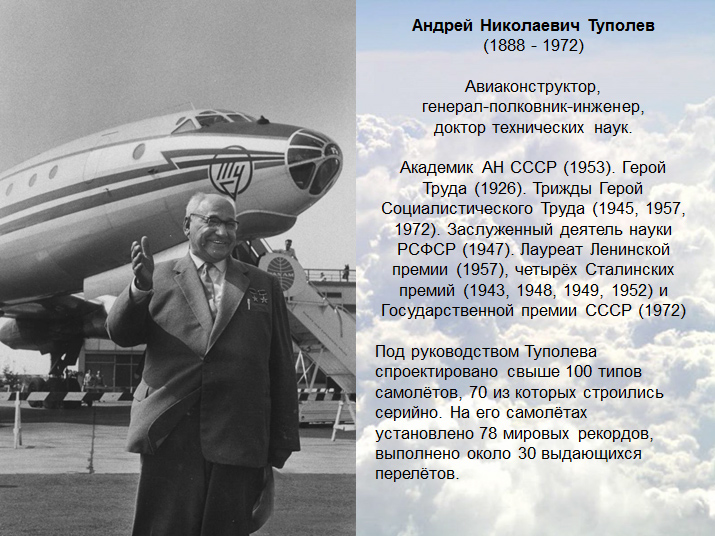
June 11, 1954 the Resolution of the Council of Ministers of the USSR № 1172-516 on the establishment of passenger aircraft Tu-16P, later called the Tu-104.
In December 1954, the work on the aircraft mock-up committee has been completed.
In March 1955 at the pilot plant of A.N. Tupolev Design Bureau (Moscow), the first Tu-104 was built.
17 June 1955 (just one year after the release of the USSR Council of Ministers !!!) in Zhukovsky the experimental aircraft made its first flight.
In parallel, preparations were made for the production of aircrafts mass production at the Kharkov aircraft factory (KAZ).
From June 17 to October 12 1955 KB A.N. Tupolev holds Zhukovsky factory testing (lead test pilot Yu.T. Alasheev, leading engineer V.N. Benderov).
5 November 1955 took off the first serial aircraft manufactured at the Kharkov aircraft factory.
From 31 January to 15 July 1956 the state tests on the experimental aircraft (chief test pilot A.K. Starikov, chief engineer A.V. Kochetkov) were held in GK Research Institute of the Air Force.
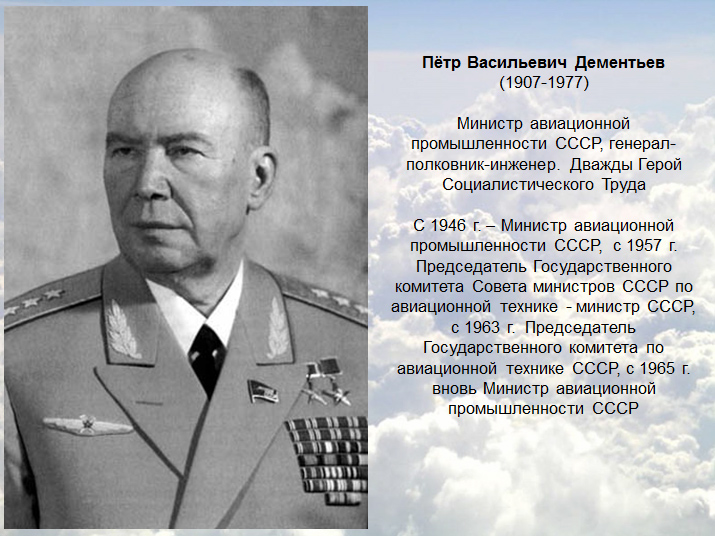
Almost at the same time with the state tests began operational testing of two mass production aircrafts at Vnukovo. At this time, a group of command and flight crews of Aeroflot, graduated from retraining to jet technique in the Voronezh Center of combat training of the Air Force, started flights on Il-28 and Tu-16.The staff was determined by the order of the chief of GU GVF. the commanders of the ships included in this group: Sapelkin K.P. Mihaylov P.M., B.P. Bugaev, V.A. Filonov, Devyatov P.I., L.I. Egorov, G.D. Kuznetsov, Orlovets I.V. .; navigators: Dubovitsky A.G., Kryatov V.K., Nosov N.F., Solyanov N.D. .; specialists of the Aviation Engineering Service: Gal'chuk V.I., Gratsiansky G.A., Nekrasov P.N., M.I. Volga, Sysoev A.A. and many other wonderful flight and ground personnel. Don’t have time to name all the specialists, but they are included in the history of civil aviation and grateful memory of posterity.
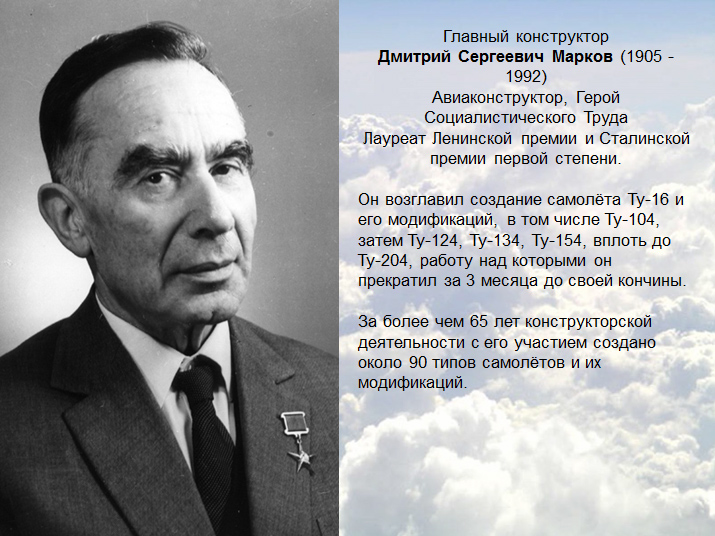
So, the captain B.P. Bugaev (later our great Minister) made a lot of flights on IL-28 for the delivery of mail from Moscow to Novosibirsk, Sverdlovsk, Khabarovsk. He shared memories, calling these flights difficult and strained, as front-line bomber was poorly adapted to long civil flights.
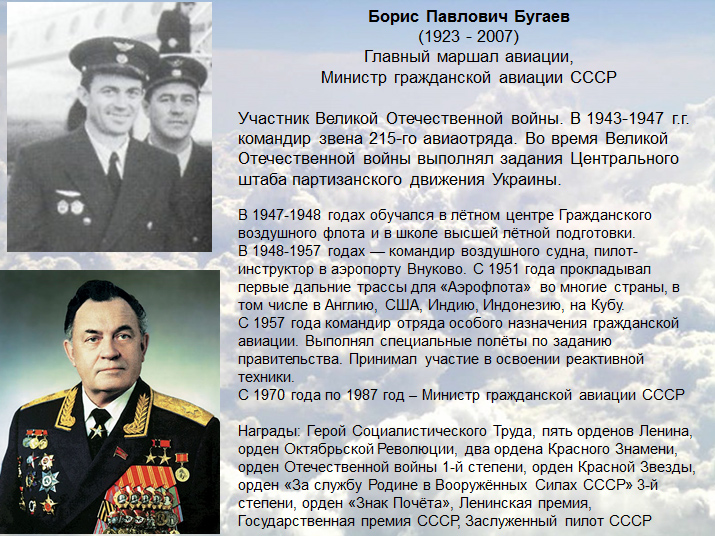
Retraining on the Tu-104 of the crews mastered flying on Il-28 and Tu-16 took place directly in Vnukovo training squadron with the commander K.P. Sapelkin.
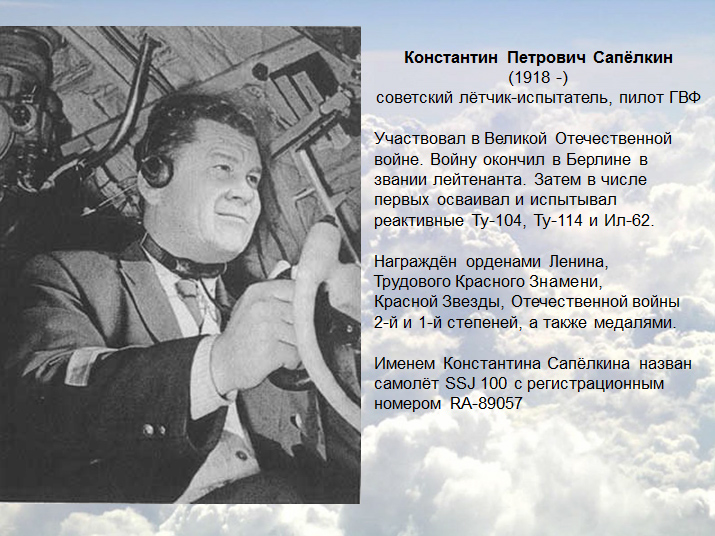
In March 1956 at the Moscow management of transport aviation (Head of Department Alekseev S.M.) squadron established jet № 200, which was headed by V.A. Filonov and Sapelkin K.P. IAS senior engineer squadron was appointed Schneiderman S.Ya. With strong leadership the squadron, flight instructor B.P. Bugaev, Shapkina M.M. Nosov N.F. senior navigator, commander of a training squadron Basov M.I. squadron № 200 started to fly on the Tu-104.
In the training of civil aviation to operate Tu-104 a very substantive and personally involved was the chief GU GVF Air Marshal Semyon Fedorovich Zhavoronkov, and then Air Chief Marshal Pavel Fedorovich Zhigarev. To conduct operational tests in February 1956 a commission was established under the chairmanship of the deputy chief of GU GVF Ye.M. Beletsky.
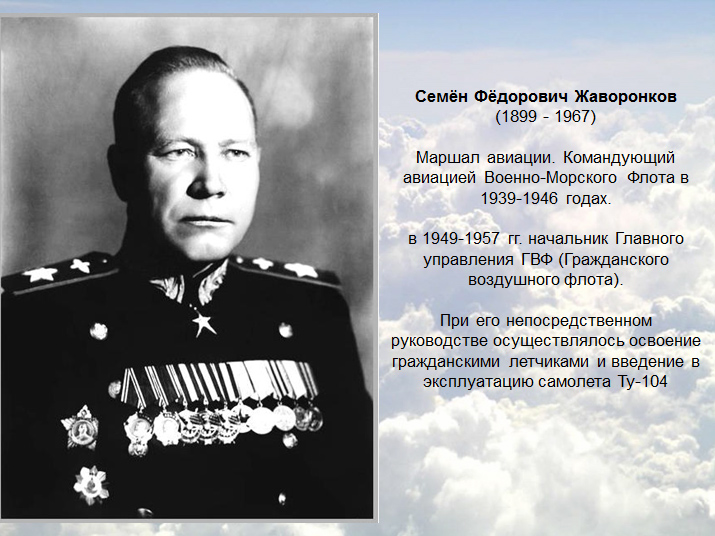
Complicated machines required the organisation of a new maintenance process. IAS was transformed into a linear operating repair workshop. The hangar was handed over to the ARB-400, where was partially (the bow propulsion, chassis) placed the aircraft. The IAS was created on separate brigade service of aircraft engines, landing gear, fuselage, tail and wing, board equipment. Formed Technological Design Bureau (TCB), which developed regulations and maintenance technology, small-scale mechanisation, tools, test benches for aeronautical and avionics. The work of the technical control department was strengthened. The solutions of many problems was carried out in close cooperation with Tupolev and the State Research Institute of Civil Air Fleet (Head Rebrov N.M.).Among the first aviation Vnukovo specialists started development the first jet aircraft operation were Galkin A.A. Gromov V.E., Nozdrin N.R., J.A. Rumyantsev, Mordvinov V.A., Larin M .I., Yatsun V.F., Bulanov N.A. N.A. Mitkovets, Sulatskaya R.P., Abramova L.V., Potapov N.V. and many, many others. Before the beginning of regular flights of Tu-104 in PG GVF measures to overhaul of aircrafts have been identified in the ARB № 400 and also its service at airports (the presence of IAS specialists trained runway, airport terminals, machinery).
Most of the work on the implementation and to ensure the successful operation of the Tu-104 was given to the GU GVF experts:
- G.V. Voitsekhovitch - Head UIAS;
- Mayboroda Yu.V. - Deputy Chief UIAS;
- Ivanov P.A. - Head of Department;
- V.E. Kirievsky - Head of Department;
Also want to recall Mashovets N.T., Head of RTU; N.N. Cherniavsky, head LERM Vnukovo; Prevezentsev V.V., Chief LERM Sheremetyevo; Fedorov E.N., Head of Domodedovo LERM and Lykhin A.K., chief engineer of the East-Siberian governance.
Major changes have been made in the management of air traffic. In CAB CAF there was organised an independent Management of flight and movement service, headed by Aleksei Ivanovich Semenko who later became First Deputy Minister of Civil Aviation of the USSR. In view of the exploitation high-speed high-altitude technics there was prepared the manual for the management of air traffic. In its development have taken an active part Ivoninsky A.A., Gurevich M.I., Andreev V.A., Akimov V.I., Rybchevsky L.L. There was introduced the temporary leadership of separation, methods of continuous radar monitoring flights of jet aircraft from take-off to landing.
From May to September in 1956 at Vnukovo aviation enterprise under the methodical guidance of the State Research Institute of Civil Air Fleet performance tests of three Tu-104 Zero series were conducted. In August 1956, it took off and later joined the operational testing of the first Tu-104 head series.The performance tests of the Tu-104 took the real professionals actively involved: pilots Vnukovo squadron № 200 E.P. Barabash, Sapelkin K.P. B.P. Bugaev, Orlovets I.V. .; leading engineers Research Institute GVF Teteryukov A.M. Deloveri V.G., Kurkov P.F., Padalko M.S.
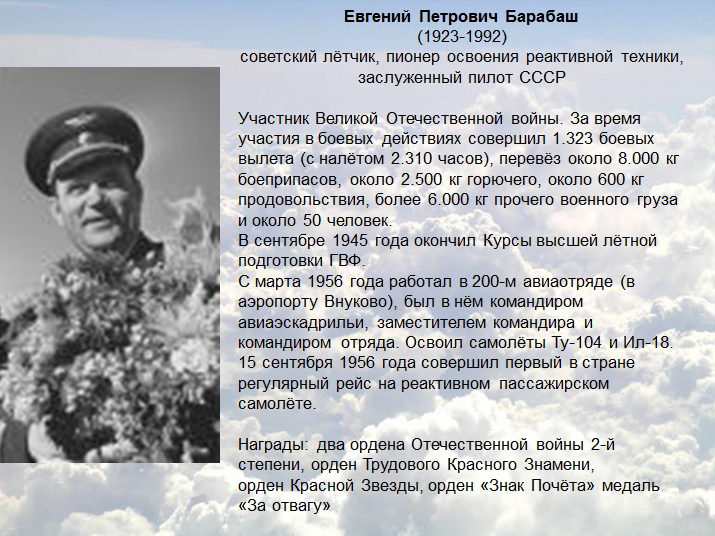
From May to September in 1956 at Vnukovo aviation enterprise under the methodical guidance of the State Research Institute of Civil Air Fleet performance tests of three Tu-104 Zero series were conducted. In August 1956, it took off and later joined the operational testing of the first Tu-104 head series.The performance tests of the Tu-104 took the real professionals actively involved: pilots Vnukovo squadron № 200 E.P. Barabash, Sapelkin K.P. B.P. Bugaev, Orlovets I.V. .; leading engineers Research Institute GVF Teteryukov A.M. Deloveri V.G., Kurkov P.F., Padalko M.S.
September 12, 1956 order of the Chief GU GVF was allowed to open regular flights by Tu-104 with passengers, mail and cargo on the route Moscow - Irkutsk 3 times a week, what was made on 15 September.
October 12, 1956, B.P. Bugaev`s crew executed the first scheduled flight with passengers on the route Moscow - Prague.
Intensive development of new routes has began. Tu-104 aircraft compared with Il-14, approximately increased speed by 3 times, flight altitude, the number of passengers on board. It was a powerful impetus to the comprehensive development of civil aviation. Regular flights began from Moscow to Tashkent, Tbilisi, Khabarovsk, Novosibirsk, Beijing, Budapest, Copenhagen. Only on these 9 directions in 1958 was made more than 17.5% of the total traffic of Aeroflot.
Tu-104 aircraft carried out a number of successful flights. 4-8 September 1957 the crew of the Tu104 as part of the commanders of the ships B.P. Bugaev, Mikhailov P.M., Orlovets I.V. and Devyatov P.I. with a senior leader of the flight A.I. Semenkov for the first time in the history of jet aviation executed a transatlantic flight from Moscow to New York. The length of the route round trip was 18 thousand km, flight time - 24 hours 36 minutes.
Experience of operation of the aircraft within a year in the Moscow transport management was widely spread in other departments of Aeroflot - Eastern Siberia, Western Siberia, the Far East, North, Uzbek, Georgian and Ukrainian, and also in the 235 squadron (for the period 1959-1961. it made 300 flights to foreign countries). Tu-104 has become an indispensable hard worker on main routes. In a country with huge territory, it gave the public greater savings of time. On the route Moscow - Khabarovsk commercial speed increased from 230 to 600 km / h, and on the route Moscow - Tashkent - from 240 to 720 km / h. The time spent in transit to these routes was decreased by 3 times. In 1960 compared to 1958 the passenger traffic increased by 2 times.
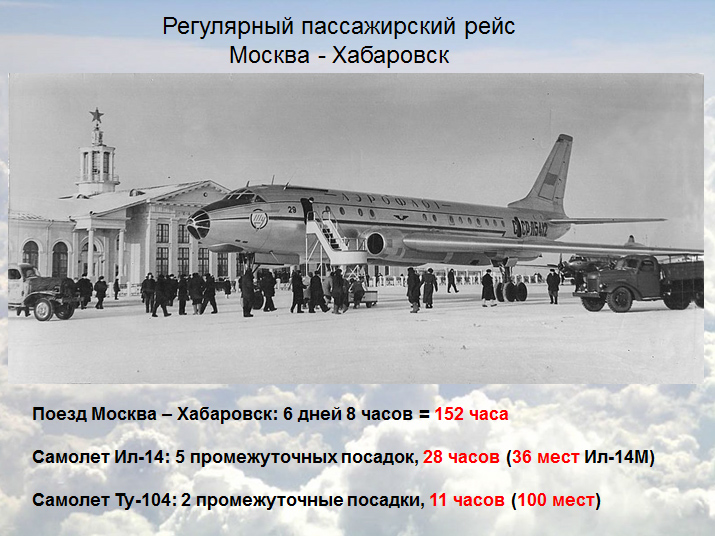
Until the spring of 1957 the Vnukovo airline was the only operator of Tu-104. Further, the number of companies of this aircraft began to grow rapidly:
- April 25, 1957 the first regional owner of the Tu-104 was the Irkutsk airline having at their disposal aircraft of the USSRL542 (42327) - the first prototype of the Tu-104A. Compared with the previous basic design Tu-104A there were set the AM-3M engines with increased thrust, bringing the number of seats to 50 was adjusted to 70;
- July 10, 1957 by the operator of the Tu-104 was the Novosibirsk Tolmachevo airline. - Sverdlovsk - Moscow (FAC Kupalo V.P.) on July 12 the first flight on the route Novosibirsk was made
- In January 1958, a Tu104 (FAC Sapozhnikov AP) made the first regular flight from Khabarovsk to Petropavlovsk-Kamchatsky;
- In April 1958, the crew of the FAC Samadalashvili I.Z. made the first flight Tbilisi - Moscow;
- In April 1959 the Tu-104B aircrafts became operated by Pulkovo airline Northern CAF governance. The crew of the FAC Zlobin made the first flight Leningrad - Moscow;
- In January 1960 for operation at the foreign routes Sheremetyevo air enterprise received new aircraft Tu-104A;
- In May 1960, the Tu-104 aircrafts were in operation at the Odessa air enterprise;
- In July 1960 in Kiev`s Boryspil air enterprise began receiving new aircrafts Tu-104B, and Tu-104A transmitted from other airlines.
Since 1959, improvements began to increase the number of passenger seats in the aircraft. The result was:
- 85 and 100-seat aircrafts Tu-104B, created on the basis of Tu-104A;
- 105 seat planes, created on the basis of Tu-104B (Irkutsk, Tbilisi and Khabarovsk airline);
- 110-seater aircrafts Tu-104B (Vnukovo, Odessa Boryspil and airlines);
- 115-seater aircrafts Tu-104B (Pulkovo air enterprise).
Tu-104 aircrafts were very demanding on the length and runway surface. In this regard, in addition to basic and international airports, flights of Tu-104 were performed in a limited number of Soviet airports - Chelyabinsk, Sukhumi, Mineralnye Vody, Kutaisi, Perm, Aktobe, Semipalatinsk, Bratsk, Barnaul, Simferopol, Petropavlovsk-Kamchatsky, Vladivostok.
Many airports (Vnukovo, Pulkovo, and others.) required the runway lengthening, equipment of landing facilities, reconstruction and construction of the airport terminals. The most positive role was played by sharing and basing airfields with the Ministry of Defence of the USSR (Sheremetyevo, Tolmachevo, Boryspil, Petropavlovsk-Kamchatsky, Vladivostok, and others.). Then a part of these airports was transferred to the Civil Aviation Authority and has been further developed, for example, Sheremetyevo, Tolmachevo, Boryspil and others. Part of the civil aviation airports built from a zero cycle (Domodedovo, Khabarovsk). At Domodedovo airports, Khabarovsk, Sheremetyevo, Tolmachevo modern hangars were built. The first divisions exploiting Tu104 were established in Irkutsk and Khabarovsk. It was a long-term national strategy - aerofication of the huge country, the air communication with the most distant regions.
Since 1972, with the advent of the Tu-154 the exploitation Tu-104 began reducing. The released aircrafts were transferred to the East Siberian Department of Civil Aviation and the Odessa squadron. 5 Tu-104A and 6 Tu-104B were rebuilt in the cargo version. Since 1977, the list of operators of the Tu-104 began reducing rapidly. November 20, 1979 Tu-104B USSR42485 from Odessa last passenger flight was performed.
Was the aircraft Tu-104 economical in our understanding? Of course not and could not be. There were strong in those times AM-3s. But they were the first generation of gas turbine engines and specific fuel consumption in their cruise was 1 kg / kg of thrust per hour. Now in modern airplanes it is 0.56 - 0.58 kg / kg of thrust per hour. But it is due to its speed (850 km / h) and passenger capacity (up to 115 people) had a flight the performance is 8-10 times higher than that of Il-14. It has identified the rapid growth of air traffic and the development of civil aviation.
Was the Tu-104 a reliable and easy to operate? We can not say this in the affirmative. It didn't always forgive crews’ errors. Furthermore, during operation there were design deficiencies which lead to disaster. During 23 years of operation were lost 30 aircrafts. This represents 15% of the number built . By the way, 190 Boeing 707 aircrafts of built 1000 (17%) were lost. "Pioneers", unfortunately, have to pay dearly when moving towards the goal.
We can not forget the disaster of an entirely new Tu-104 USSR-42362, which fell on the territory of the Chuvash Autonomous Republic on October 17, 1958. The crew was run by one of the most experienced commanders Harold Dmitrievich Kuznetsov performing flight Beijing - Moscow (Chinese and Korean delegations). On board were 71 passengers and 9 crew members. At an altitude of 10 000 m the aircraft hit turbulence with strong vertical gusts.
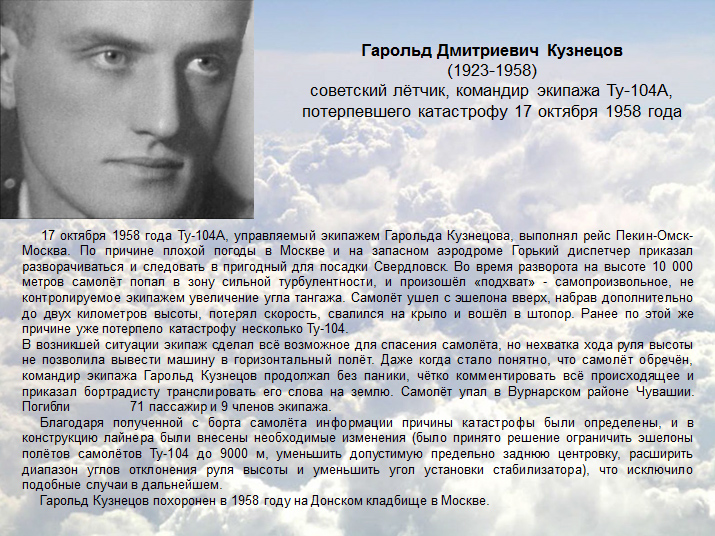
There was an aircraft "pickup" - spontaneous uncontrolled by crew increase in the pitch angle. The aircraft left the echelon to a height of 13 000 m, lost speed and fell on the wing went into a tailspin. The crew did everything possible to save the aircraft and passengers. But the shortage of diving rudder was unable to bring the aircraft to the horizontal flight. Kuznetsov knew that three months ago, on August 15 in the region of Birobidzhan from echelon fell Tu-104A USSR L5442. The reason for the disaster remained unclear. Continuing to struggle in the current situation, Harold Dmitrievich led the report on the behavior of the machine, ordered the flight radio operator Alexander Sergeyevich Fedorov to broadcast his words to the ground. Before the goodbyes to his family and he clearly conveyed: "Pickup, the stabiliser is not enough." As known, then there was no MSRP. His information allowed to establish the cause of the disaster. Stabiliser installation angle was changed, modified height steering wheel, reduced the maximum altitude, changed the rules for aircraft centring. A good lesson: if the air crash strickes the reasons of it must be always determined.
At the cost of his life, Harold Dmitrievich Kuznetsov and his brave crew saved the lives of all Tu-104 aircrafts in the family (the aircraft could be decommissioned).
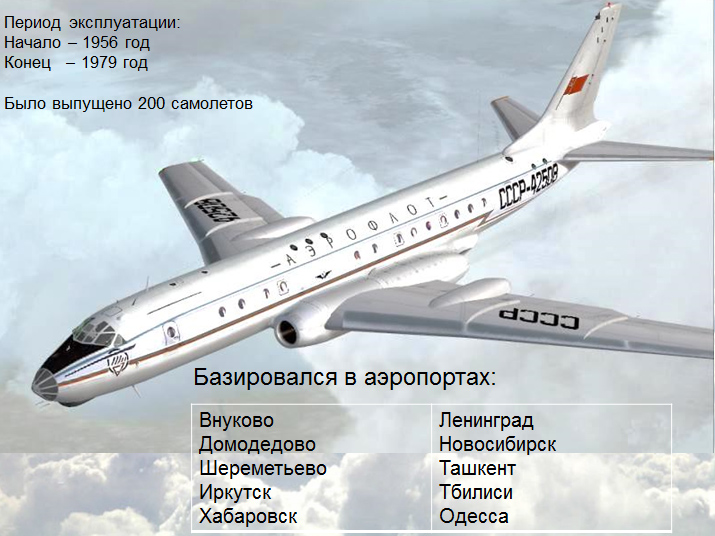
Tu-104, the period of its operation are an important part of the history of Russian civil aviation.
Thereby:
- Aeroflot took the leading position in the world of civil aviation;
- was formed highly qualified an exceptionally strong team of aviation specialists (pilots, engineers, technicians, dispatchers, ground services specialists who can master operation of any aircraft;
- the largest country in the world began to effectively aeroficate its territory, meeting the needs of society and the national economy in air services;
- created a unique training system of aviation specialists top and middle level, recognised worldwide. Strengthened and further developed the national aviation tradition. It is well known that a good aviation specialist is not enough to teach and train - the specialist must be raised.
- gained a great experience in successful operation of complex modern aviation technology, without which it would be impossible to successfully operate the next-generation aircrafts (Tu-114, Il-18, Tu-134, Tu-154, Il-62, Il-76, Yak-40, An-24, Yak-42, Il-76, Il-96, Tu-204), all types of helicopters and other aircrafts, which were operated in the Russian civil aviation. This experience is valuable, lessons are instructive. Thank you "pioneers"!
.jpg)











